
Biosensory devices linked to smartphone apps are already part of mainstream sports. Athletes use wearable technology to capture and communicate data, usually by electrocardiography or pulse oximetry (a non-invasive way to monitor O2 saturation), helping them to optimize their performance. But a new and much bigger wave of wearable analytic devices is about to hit the big time: chemical sensors.
Chemical sensing offers an almost limitless range of potential uses, including the tracking of personal health metrics, the exquisitely accurate measurement and maintenance of drug levels in patients and the monitoring of all kinds of potential threats in the external environment. Some of these applications are likely to be available in the medium-term (three to five years), others in the long-term (more than five years); in the first wave of applications, which is about to wash over us, sports applications again figure prominently. One of the people at the forefront of wearable chemical biosensor research is Joseph Wang, a professor of nanoengineering at the University California San Diego (UCSD), USA. Wang, who was listed among the 100 most influential people in the analytical sciences by this magazine last year, says that, “Virtually everyone will find some wearable sensor useful, and most of us will want multiple analyses, perhaps on a constant basis: for monitoring sick people, or even babies, for assessing pollution, for measuring physical performance and even detecting pathogens.”
According to Transparency Market Research, the market potential for wearable biosensors is huge; reaching a market value of $18.9 billion by 2018. Their recent report states: “The biosensors market is expected to witness considerable growth owing to its wide array of applications in diabetes monitoring, cardiac monitoring, drug discovery, agriculture, environmental and bio-defense practises. Rise in diabetes population coupled with demand for home care diagnostics and point of care diagnostics have boosted the growth of this market. In addition, use of biosensors in non-medical applications is expected to further enhance the growth of this industry, ” (1). IDTechEX, another market research and business intelligence firm, paints a broader picture of the size of the market that includes biosensors. “As the wearable electronics business powers over five times from over $14 billion today to over $70 billion in 2024, the dominant sector by value will remain the increasingly merged medical, healthcare, fitness, wellness sector, ” (2).
While the opportunities seem almost to mirror those of the electronic apps market, the costs, complexity and barriers to success for wearable sensors are considerably higher. Pankaj Vadgama, professor of biomedical engineering at Queen Mary University of London, UK, and another leader in the field, is one of a number of experts who take a guarded view. “I am aware of commercial ventures,” he says. “However, I think it will be at least 10 years before we see in-body and on-body biosensors as commonplace devices.” His concerns are not with the front-end biochemistry which, he says, works fine and is often very efficient, Vadgama sees, “the big challenge as providing reliable monitoring in the face of tissue hostility and to offer safe, sterile components that can be stored and used on demand.” There needs to be a convergence with biomaterial developers to enable safe interfacing with human tissue, he believes. Others are more bullish, including Joshua Windmiller, co-founder and CEO of Electrozyme, a startup in the biosensor space that was spun out of Wang’s Laboratory for Nanobioelectronics. Windmiller views the field as a new frontier, wide open to innovation. It needs, he says, “radical ideas to develop devices that will augment the information provided by existing biosensor technology.”
With potentially thousands of disparate new wearable devices being developed over the coming decade, it seems likely that an aggregator of products for the consumer market will emerge. Windmiller thinks it might be a job for an Apple or a Samsung. “An ecosystem for ‘wearables’ equivalent to the Apple app store would be a major game-changer,” he believes. Such a Wearable Biosensor Store would both promote consolidation – meaning that the best devices would become enormously popular – and encourage harmonization – so that disparate devices could work together and communicate with each other. “The ultimate aim would be to present information to the user in an intuitive way that doesn’t overload them with data,” Windmiller says. For developers of wearable devices, as with electronic apps, the key challenge will be to differentiate their product in a meaningful way. “In Electrozyme’s case, the key difference is that we go beyond measuring basic and crude physical metrics like heart rate,” Windmiller says. “We remain the first and only commercial enterprise analyzing the chemical constituents in sweat and other bodily fluids.”
Time to market, cost of development and the competitive landscape will vary dramatically with the function of the wearable device: it will be a much longer haul for healthcare than for non-healthcare applications, which largely explains why sports applications are to the fore in these early stages. “The cost of clinical validation to commercial standards and safe distribution with minimal operator demands is a major challenge,” Vadgama notes, while Windmiller says, “there is a way to go as the latest FDA [US Food and Drugs Administration] ruling states that any mobile application that deals with healthcare must be regulated and scrutinized by the organization.” What is not in doubt is the value of technologies that could help patients manage their condition in their own homes. “While more insight is required into physiological and metabolic processes,” Windmiller says, “such biosensor developments will help people avoid dehydration, falls, seizures and traumatic brain injuries.” These are targets that are both worthwhile and lucrative, so it is no surprise that there is already a well-established biosensor industry developing devices with medical applications, including prominent global corporations like Roche Diagnostics, Abbott Point of Care, Siemens Healthcare Diagnostics and Medtronic Diabetes. One of the fascinating battles of the next ten years will be to discover if the benefits of wearables devices, such as simplicity, user-friendliness and low cost, developed by upstart new companies will compete with more traditional products from established players.
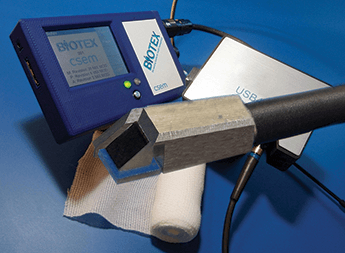
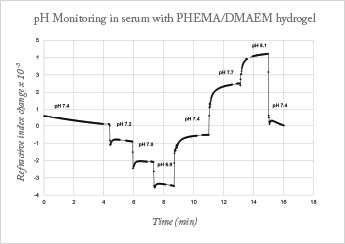
Despite being in its infancy, the potential of wearable devices for healthcare is already apparent in the following examples. Monitoring wound healing Researchers at Centre Suisse d’Electronique et de Microtechnique (CSEM), a private non-profit company in Neuchâtel, Switzerland, have designed an optical sensing system for in-situ monitoring of wound healing (3). Its primary use is to monitor chronic wounds, which fail to heal in an orderly set of stages and in a predictable period of time, causing sufferers severe emotional and physical stress. The biological basis of the technology, explains Guy Voirin, head of the Biosensing group at CSEM, “is to monitor the wound healing process continually, by measuring the pH, the concentration of inflammatory proteins such as C-reactive protein (CRP), or the concentration of matrix metalloproteinase (MMP). Different optical fibres and optical microsystems have been developed for this. For example, optical fibres surrounded by a sol-gel layer that contains pH-sensitive dyes (the pH of the wound changes depending on the stage of healing) are incorporated into wound dressings (see Figure 1). A white light source from a light-emitting diode (LED) and a spectrometer are used for detection, making it possible to capture and communicate real-time information about the wound and assess novel therapies.
Google’s vision of diabetes management A smart contact lens that measures glucose levels in tears is being tested by Google[x], the same group that brought us Google Glass. Built into the lens, embedded between two layers of soft contact lens material, is a miniature wireless chip and glucose sensor that can, in prototype form, generate a reading every second. The aim of the technology is to help diabetic patients to manage their disease and they are investigating built-in early warning system that uses miniature LED lights to inform the wearer when a glucose threshold is reached. The company is in discussions with the FDA and plans to look for an industry partner to bring the technology to market.
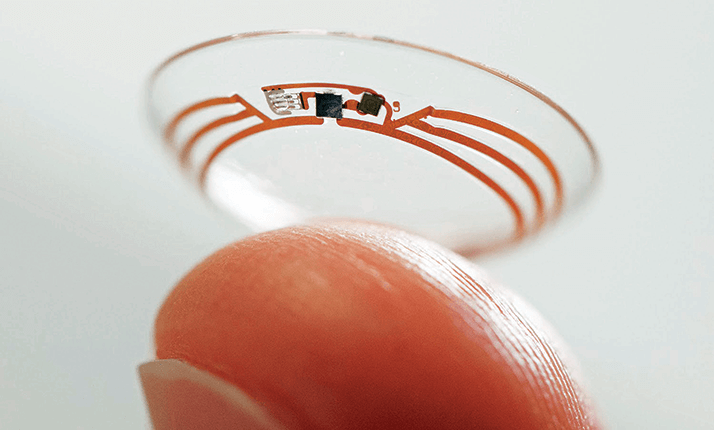
Hard hat detects CO The exhaust from gasoline-powered hand tools in enclosed spaces places construction workers at risk from carbon monoxide poisoning. Now, a wearable has been developed by the group of Tom Martin, associate professor of electrical and computer engineering at Virginia Polytechnic Institute and State University, Blacksburg, VA, USA (4). The work adapts a pulse oximetry sensor – monitoring for O2 and CO simply differ in the number of wavelengths of light employed – and incorporates it into a hard hat. Research indicated that the sensor helmet would warn the wearer of imminent CO poisoning with a probability of greater than 99 percent. Although the group has not looked extensively at commercializing the work, it is an option as the major research questions have been addressed, plus the technology is a good fit for mining and other hazardous operations.
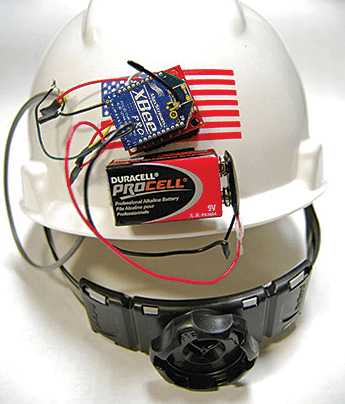
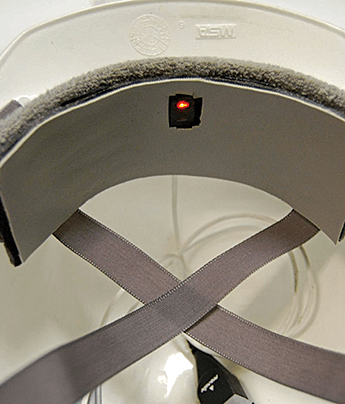
Scene-of-crime investigations At crime scenes, speed and simplicity are critical. Currently, the identification of explosive or gunshot residue can be a laborious process, requiring the painstaking collection of samples, their transport to a laboratory and a complex analysis procedure. Wang and his colleagues have developed a short-cut: a portable system that perform the test on site, in about four minutes, with no need for additional liquid reagents (5). The system comprises two fingertip sensors. One is a sheath worn on the index finger, which incorporates a screen-printed electrode; the other, worn on the thumb, is an electrode-equipped sheath that is coated with a solid state ionogel electrolyte. All that the CSI has to do is run his or her suitably-equipped index finger over a surface of interest and then press it against the thumb. The voltammetric signal produced by the electrochemical reaction is read on a portable electrochemical analyser, enabling the identification of the various peaks for gunshot residue and explosives.
Vadgama and Benny Lo, who is non-clinical lecturer in medical robotics at Imperial College London, UK, are involved in the Elite Sport Performance Research in Training (ESPRIT) program. ESPRIT’s objectives including success at Olympic and other international sporting events and the application of achievements in sport to technological transformations in healthcare, wellbeing and chronic disease management. “Our research team has developed oxygen, glucose and lactate sensors for subcutaneous implantation and short term monitoring during exercise,” Vadgama says. “The sensors are based on stable membrane components that allow devices to operate inside the body with safety and stability; we have performed human trials of these devices. We have also devised solid-state sensors for metal ions that can be used on the skin for sweat analysis during exercise.”
The non-invasive lactate monitoring system developed by Wang’s group uses electrochemical reactions directly on the wearer’s skin; it is being commercially developed by Electrozyme, and the company anticipates its first product will hit store shelves within two years. As described in an earlier issue of The Analytical Scientist (6), the biosensor is applied to the skin as a temporary tattoo and measures lactate levels in sweat (7). It incorporates three screen-printed electrodes, one of which has a lactate oxidase coating to provide chemical selectivity; it converts lactate to pyruvate, with the released electrons detected and monitored by an attached device. Unlike other monitors that interpret caloric loss using algorithms, the Electrozyme product assesses sweat rate and can accurately work out how many calories an individual is losing over time. The athlete attaches an Electrozyme temporary tattoo to the skin and its accompanying arm band relays the information to a mobile device. He or she can monitor performance and increasing/decreasing levels of fitness, enabling fine-tuning of exercise programs.
More recently, Wang’s team have developed a mouthguard sensor to monitor metabolites in saliva, potentially providing real-time information on the health, fitness and stress status of the wearer (8). Mouthguards are widely used in sports to prevent dental injuries. The device incorporates a printable amperometric enzymatic biosensor within an easily removable mouthguard platform (see Figure 2). Lactate is being monitored as a proof of concept in an initial application, but the system can be adapted to analyze other clinically relevant metabolites and biomarkers such as cortisol, norepinephrine and glucose, thereby providing a broader or more targetted view of a wearer’s health and performance. Further refinement of the approach will see miniaturization of the amperometric circuits and the integration of electronics for data acquisition, processing and wireless transmission, together with assessing potential toxicity and biocompatibility.
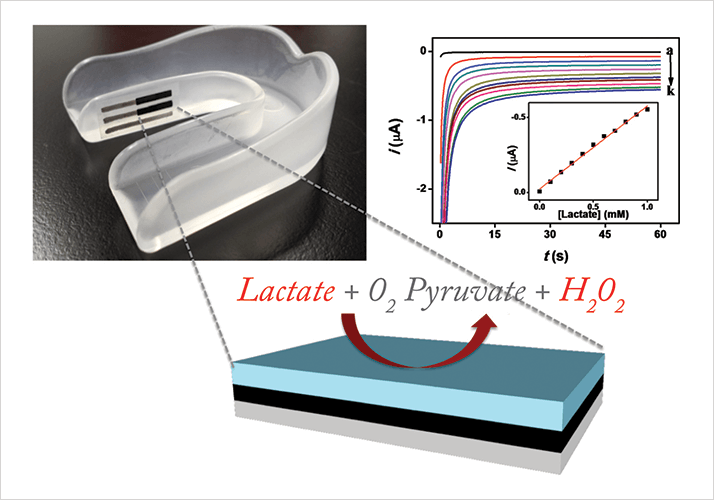
With wearable biosensors increasing in number and complexity, the next stride forward will come in the form of self-powered sensors. Wang is working in this too, developing an intriguing biofuel power source that makes biosensors independent of external power supplies like batteries. The self-powering units borrow the idea of the temporary tattoo but utilise the lactate in sweat for energy production. Wang is working with Evgeny Katz of the Department of Chemistry & Biomolecular Science at Clarkson University, Potsdam, NY, USA, to apply the biofuel cell-powered biosensor concept to drug delivery for pain relief (9). To achieve this (see Figure 3), a “nanopharmacy” is activated by injury biomarkers (for example, excess lactic acid) triggering release from one of the electrodes. Using Boolean logic to regulate the release of the drug, the system only delivers as much of the drug as is needed to treat the pain.
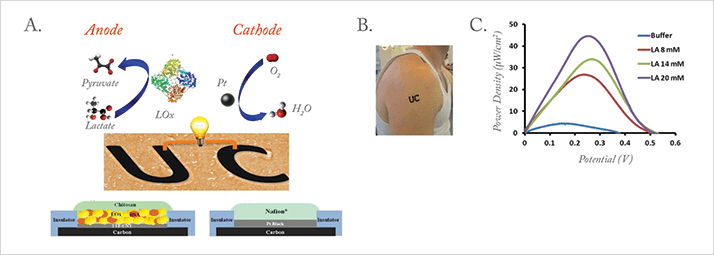
The nanopharmacy has an enzyme-based logic gate on its anode and a cathode containing paracetamol. When both lactic acid and lactate dehydrogenase (LDH) are present, LDH catalyses the production of pyruvate from lactic acid, using nicotinamide adenine dinucleotide (NAD+) as an oxidising agent. The subsequent NADH from the reaction releases electrons to the fuel cell. The LDH and lactic acid, therefore, perform the function of an AND gate, and the cathode releases the painkiller only when the injury biomarker (lactic acid) is detected and the circuit is completed. The work is funded by the Office of Naval Research, with the goal of developing a complete nanopharmacy that will monitor and treat soldiers in the field. For other applications, such as maintaining appropriate doses of cancer drugs in patients, it should be possible to integrate sensor-triggered drug delivery on a microneedle array platform (see Figure 4).
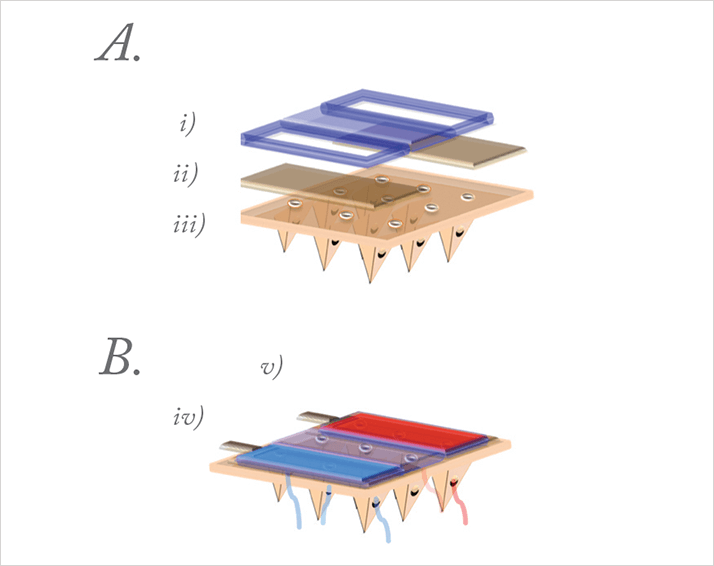
For the next 10 years, there should be substantial developments in biosensors, particularly with the “Internet of Things” connecting diverse devices and communicating data over a proven, standard network. The technological and biochemical solutions are not necessarily high hurdles to jump for those who are keen to develop the field – a regulatory landscape that fails to keep pace may prove to be the biggest challenge. Certainly, it is the value of remotely capturing and communicating data that will really drive the market, particularly if it makes science more cost effective. Beyond human applications, there may be uses for biosensors in animal husbandry and veterinary science. For example, it would be relatively easy to combine biosensors with eartags on cattle to provide feedback on a range of health indicators. Such devices could provide immediate feedback on a wide range of biomarkers to help monitor the general health of the herd or indicate imminent disease threats, saving time and money. Pets could also benefit by integrating miniature biosensors with the microchips already used in dogs and cats to monitor elevated biomarker levels.
As illustrated by the hardhat CO detector, environmental monitoring is another potential growth area. Incorporating biosensors into wearables for people working in potentially hazardous environments would take the guesswork out of risk assessment. And the same concept could keep tabs on allergens in the atmosphere for allergy sufferers. Combined with a drug delivery mechanism, an antihistamine dose could even be administered on first contact with a known trigger. Internet-connected, self-powered, smart sensors could also reduce both waste and danger in the food supply chain. Perhaps these could be combined with electronic tags on containers that already monitor temperature and other aspects of food logistics. Building on technologies that already exist will smooth the introduction of biosensors, and the applications seem almost limitless. Where do you see the world of wearable biosensors heading? Comment for free below.
References
- Transparency Market Research, “Biosensors Market (Electrochemical, Optical, Piezoelectric & Thermistor) - Global Industry Analysis, Size, Share, Growth, Trends and Forecast, 2012 – 2018”, (2013). IDTechEX, “Wearable Technology 2014-2024: Technologies, Markets, Forecasts E-textiles, wearable electronics, medical diagnostics, smart glasses, smart wristbands and more”, (2014). S. Pasche et al., “Wearable Biosensors for Monitoring Wound Healing”, Advances in Science and Technology, 57, 80 (2008). J. B. Forsyth et al., “Feasibility of Intelligent Monitoring of Construction Workers for Carbon Monoxide Poisoning”, IEEE Trans. on Automation Science and Engineering, 9(3), pp. 505-515, July (2012). A. M. O‘Mahony and J. Wang, “Electrochemical Detection of Gunshot Residue for Forensic Analysis: A Review”, Electroanalysis, 25: 1341–1358. DOI: 10.1002/elan.201300054 (2013). R. Whitworth, “Analytical Tattoo”, The Analytical Scientist, 10, 9 (2013). W. Jia et al., “Electrochemical Tattoo Biosensors for Real-Time Noninvasive Lactate Monitoring in Human Perspiration”, Anal. Chem., 85, 6553 (2013). J. Kim et al., “Non-invasive Mouthguard Biosensor for Continuous Salivary Monitoring of Metabolites”, Analyst, 2014,139, 1632-1636, DOI: 10.1039/C3AN02359A, Received 25 Dec 2013, Accepted 24 Jan 2014. First published online 24 Jan 2014. Ming Zhou, et al., “A Self-Powered “Sense-Act-Treat” System that is Based on a Biofuel Cell and Controlled by Boolean Logic”, Angewandte Chemie International Edition, 51(11), 2686-2689 (2012).
